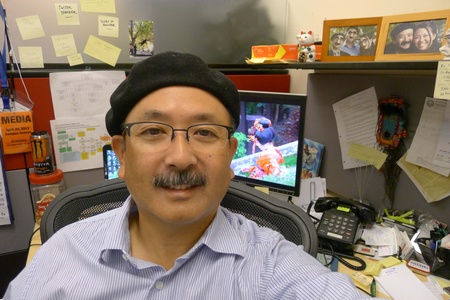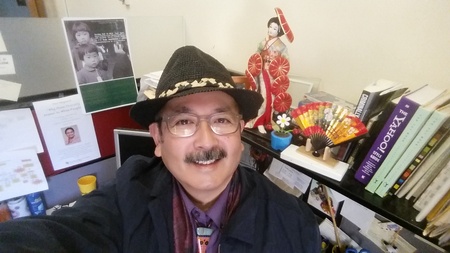Here’s all the dirt on my feelings about cleaning.
I don’t have the joy of cleaning.
Maybe it’s because I’m male. Maybe it’s because my family came to the US when I was only 8 years old. Maybe it’s because I’m just a rebellious dude.
I hate cleaning. Not myself or my body, mind you—I like to be personally clean (except for my language). I take showers every day and dislike outdoorsy activities like camping because it means I can’t take a shower until I get home.
I mean cleaning house. Uh, more caveats: Oh sure, I do it. I’m the designated vacuumer, dishwasher, cat litter scooper, trash taker-outer, kitchen mopper, lawn mower. Maybe it’s because all those tasks are for communal areas.
But I’m not big on cleaning up my personal stuff. Anyone who’s seen my desk at any of my jobs knows I’m a typical journalist. There are papers scattered all over, various pens, bits of food, cans (mostly empty) of energy drinks stacked against the cubicle wall, cables and wires all crazily snaking their way across my desk.
Growing up, I had a knack for tidying up so things looked neat (more on that in a bit) but even that seems to have gone by the wayside as I’ve become a cranky old fart.
I’ve been thinking about this because a Japanese organizing consultant and author, Marie Kondo, has been making the rounds of talk shows and NPR interviews all this year, and I just saw another online article about her.
In her bestselling first book, The Life-Changing Magic of Tidying Up, Kondo, who goes by the very Japanese-y nickname “konmarie,” gave her big tip for decluttering your life: hold something in your hand and ask yourself, “Do I get joy from this?”
If it’s not joyful, you chuck it. Simple as that. She’s become so popular with her appearances and videos that “konmarie-ing” has become a verb, to simplify/declutter/clean. Her new book is titled, Spark Joy.
Me, I’m an old-time packrat. Somewhere in the basement is an old basket of matchbooks I collected for decades and kept, even though I no longer collect them (who has matchbooks anymore, anyway, come to think of it?). I have artwork from when I was in high school and college (I went to art school, so maybe that’s not so surprising). I have some vinyl albums, cassettes, and CDs I’ve lugged around from house to house, marriage to marriage…even though I no longer ever listen to them. Maybe they give me joy. Or maybe they’re just clutter.
I’ll have to think about that.
I also have a bad habit of saving papers from meetings, conferences, and conventions. You know those goodie bags they give you at conventions with useless program books (I look things up on my phone now) and random promotions from sponsors and maps and lists of things to do in the city? I usually bring them home and they grow like a fungus at the foot of my bed, or on my dresser. My mom’s word for my environment would be “gatcha-gatcha,” a hot mess.
Once a year or so I try to throw most of that stuff out. But I still have several bags of booklets, pamphlets, fliers, menus, and other ephemera from all my trips to Japan that I can’t seem to make myself toss. A month ago, I did get a wild hare and went through my dresser top and cleaned it up. I thought my wife Erin was going to have a heart attack—she hadn’t seen the actual top of my dresser in years.
Over the Fourth of July weekend, I put together some Ikea furniture including bookshelves, and moved around older shelves into the bedroom (and one by the TV downstairs) for books and DVDs and Blue-Ray discs. I constantly get new books and plan to read them but just let them stack up on the floor. Erin was shocked to be able to see carpet again after I found a place in the shelves for all my runaway books. Now I have to try to read them all…. But my area looks like a different person lives here now.
When I was younger, I was able to make my stacks of books and music and papers look OK, because I was good at tidying. A stack always looks like it’s there for a reason if you make it straight and even with other stacks. A messy desk looks manageable if you straighten the pieces up and line up your pens and hide your cables and wire a bit. I take my pyramids of energy drink cans to the recycling bin. I put things in boxes and drawers. If they’re out of sight they don’t look messy. Inside the drawer is another story, though.
I don’t think my tidying process is what Kondo refers to in the subtitle of her first book, “The Japanese Art of Decluttering and Organizing.” Mine is an American response to a Japanese impetus.
I learned my personal tidying tricks as a child and teenager living with a Japanese-born Tiger Mom who was as obsessed with me cleaning as she was with me getting good grades. Studying and cleaning were pretty much the same physical act, done during the afternoon or evening in my room. I always heard her running the vacuum downstairs, then I’d hear the inevitable, “Gyubah—clean-a you room!” “OK mom,” I’d yell through my closed door, then I’d tidy things up in a minute or two so when she stuck her head in the room later, it would look clean at a glance.
Marie Kondo would have you believe this need for cleanliness, and lack of clutter is a Japanese cultural trait, and I think being Japanese does have something to do with it. After all, I grew up taking off my shoes at the front door, not just at my home but at my non-Japanese friends’ too. My mom vacuumed all the time but our avocado green shag carpet was pristine compared to some of my high school buddies’ homes, where I felt kind of gross walking in my socks on the mashed-down dirty carpets.
I should have just loaned my mom out to my friends’ families.
© 2016 Gil Asakawa








